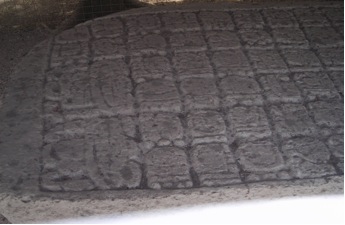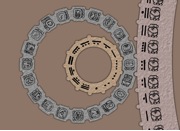- About MAA
- Membership
- MAA Publications
- Periodicals
- Blogs
- MAA Book Series
- MAA Press (an imprint of the AMS)
- MAA Notes
- MAA Reviews
- Mathematical Communication
- Information for Libraries
- Author Resources
- Advertise with MAA
- Meetings
- Competitions
- Programs
- Communities
- MAA Sections
- SIGMAA
- MAA Connect
- Students
- MAA Awards
- Awards Booklets
- Writing Awards
- Teaching Awards
- Service Awards
- Research Awards
- Lecture Awards
- Putnam Competition Individual and Team Winners
- D. E. Shaw Group AMC 8 Awards & Certificates
- Maryam Mirzakhani AMC 10 A Awards & Certificates
- Two Sigma AMC 10 B Awards & Certificates
- Jane Street AMC 12 A Awards & Certificates
- Akamai AMC 12 B Awards & Certificates
- High School Teachers
- News
You are here
Maya Calendar Conversions - Calendar Conversions: Example 1
In this section we will present a method of converting a Long Count date to the corresponding Round Calendar date. This means, given a Long Count date, we will locate it in the Round Calendar 18,980-day cycle by identifying the corresponding Tzolkin and Haab dates.
The Long Count date 9. 3. 10. 5. 3 (9 baktuns, 3 katuns, 10 tuns, 5 uinals, 3 kins) is carved in Stela D in Cobá, Mexico (see Figure 3).

Figure 3: Stela D (Photo by Millersville University student Brian Viera, 2009.)
a) We compute the number of kins (K).
| Baktun: | 9 x 144,000 | = | 1,296,000 |
| Katun: | 3 x 7,200 | = | 21,600 |
| Tun: | 10 x 360 | = | 3,600 |
| Uinal: | 5 x 20 | = | 100 |
| Kin: | 3 x 1 | = | 3 |
| Total: | K | = | 1,321,303 |
b) Now we divide K by 18,980 to determine the number of full Round Calendar cycles that elapsed up to K, and, more importantly, to find the remainder, which gives the location of the date within one Round Calendar cycle:
1,321,303/18,980 = 69 + 11,683/18980.
This means that 69 Round Calendar cycles elapsed and the date we seek is the 11,683rd kin or day from the starting date of 4 Ahau 8 Cumku in the Round Calendar cycle. Let R = 11,683.
c) Now we will determine the Tzolkin date. To do this, we divide R by 13 (days) and by 20 (gods):
11,683/13 = 898 + 9/13
11,683/20 = 584 + 3/20.
This means that 11,683 days consist of 898 13-day cycles, plus A = 9 extra days, and also of 584 20-day cycles of gods, plus B = 3 extra days (or gods). Since the Tzolkin date for the beginning of the Maya world was 4 Ahau, we add 9 days to 4 days and 3 gods to Ahau, obtaining the Tzolkin date 13 Akbal.
d) Haab Calendar Date: To determine the Haab date we begin by dividing R by 365, the number of days in the Haab calendar:
11,683 /365 = 32 + 3/365.
This means that 11,683 days consist of 32 Haab Calendar cycles, plus H = 3 extra days. Since the Haab date for the beginning of the Maya world was 8 Cumku, we add 3 days to 8 days, obtaining the Haab Calendar date 11 Cumku.
Note that if the remainder H satisfies 0 ≤ H ≤ 11, the Haab Calendar date is in the month of Cumku and is 8 + H Cumku. If 12 ≤ H ≤ 16, the Haab date is one of the 5 days of Uayeb; namely, H – 12 Uayeb. Finally, if 17 ≤ H ≤ 364, the Haab Calendar date falls between 0 Pop and 7 Cumku (inclusive). Example 2 will illustrate this last case.
e) Round Calendar date is 13 Akbal 11 Cumku by virtue of combining the results of parts (c) and (d).
The Convergence article "Maya Cycles of Time," by Sandra Monteferrante, provides an excellent graphic of the Calendar Round with an iteractive calendar, which we have reproduced in Figure 4.

Figure 4: Interactive Calendar Round
The Pictographic Maya Calendar Converter, developed by Charles Hartley of the University of Colorado, converts Julian/Gregorian calendar dates to Long Count, Tzolkin calendar, and Haab calendar dates, and includes drawings depicting how the Maya wrote the dates. Millersville University students in Math 102 regularly use this Java Applet to check the accuracy of the calendar conversions they have done by hand.
Ximena Catepillan (Millersville University of Pennsylvania) and Waclaw Szymanski (West Chester University of Pennsylvania), "Maya Calendar Conversions - Calendar Conversions: Example 1," Convergence (October 2010), DOI:10.4169/loci003536




